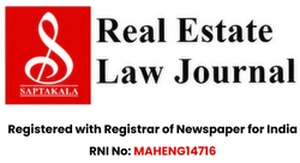 By Legal Bureau
By Legal Bureau
Handing over a building after construction
The Institute of Engineers (India), Maharashtra State Centre, organised a one-day symposium on ‘Earthquake – You and Your Abode’ pursuant to Bhuj Earthquake. A book was then published, wherein appeared an article written by Shri M.P. Raghavan covering the subject of handing over of the buildings constructed by owners/ developers, to co-operative housing society, etc. with “Do’s & Don’ts”. We are reproducing hereinbelow the said article, for the benefit of our members and readers.
Building is a products created by various agencies and the documents related to its construction must be kept with the consumer that is the occupants of the building, as ‘permanent recor’. The documents are necessary for references in future, especially at the time of carrying out additions and alterations to the building and preventive maintenance works. Documents will also help the Society for taking action against carrying out unauthorised internal changes, additions, etc.
At present, most of the developers do not hand over any records to the societies causing undue hardship to them at later stage. Regulations need to be introduced whereby the developers will be legally bound to the societies for executing the deed of conveyance within a time limit on completion of the buildings and to hand over the required documents to the societies.
Developers shall hand over atleast the following documents :
1. Property register card with CTS plan.
2. Set of approved / completion plans.
3. Occupation permission/ building completion certificate.
4. Drainage completion certificate along with completion plan of house drainage system.
5. Structural plans as executed at site with details of design and the stability certificate issued by the structural engineer.
6. Plan of electrical layout.
7. Plan of pumping layout.
8. Layout of firefighting installations.
9. Architect’s certificate for carpet area / built-up area of each flat.
10. NA permission issued by the Collector.
11. Exemption order issued by C.A. (UL C&R) Act 1976.
12. List of important agencies involved, their names, addresses, telephone numbers, etc. vis. :
(a) Architects
(b) Structural Engineer
(c) Site supervisor
(d) Licensed plumber / plumbing contractor
(e) Electrical contractor
(f) Contractor for civil work
(g) Developer
Maintenance of buildings :
A building, however sound it may be, needs regular maintenance to keep it in healthy condition. However, awareness in this respect is lacking in the occupants, which is evident from the condition of buildings in Mumbai. Occupants who sped liberally for decoration of their premises do not show the same spirit as and when they are asked to contribute towards repairs and maintenance of their buildings. It is important to carry out timely maintenance works to prevent deterioration of the buildings.
DO’s :
1. Get the building inspected by qualified engineer after 10 years of its occupation and at an interval of 5 years thereafter for structural assessment and carry out the works suggested by him.
2. Attend to all the leakages promptly.
3. Keep all the sanitary pipes, water pipes and its fittings in good conditions by replacing the broken parts promptly.
4. Check terrace waterproofing before every monsoon and attend the repairs. Renewal of waterproofing layer, whenever necessary, shall be undertaken to prevent leakage from terrace.
5. Any cracks, plaster peeling off, exposed reinforcement etc. shall be immediately brought to the notice of the structural Engineer.
6. Render two coats of waterproof cement paint for external face of the buildings at regular intervals.
(a) Cement paint every 3 years
(b) Acrylic paint
7. Preventive maintenance of lifts shall be done by giving service contracts to the lift companies. Arrange operation of lifts by liftman.
8. Keep the water pup in working conditions. Yearly contract for maintenance is advisable.
9. Firefighting installation shall be maintained through qualified agencies.
10. Keep the terrace clean, especially during monsoon.
DON’TS :
1. DO NOT allow any unauthorised additions/alterations thereby loading the existing structure.
2. DO NOT allow any internal changes without consulting the structural engineer and without obtaining prior approval of MCGM wherever necessary.
3. DO NOT allow extension of toilets or lavatories over other rooms.
4. DO NOT permit internal works such as replacement of flooring, repairs of internal plastering, repairs to RCC members, renovation of toilets or kitchen, etc. without consulting the professionals in the field.
5. DO NOT allow gardening in any manner unless specifically designed.
6. Change of internal loading shall not be allowed.
7. Subsequent additional of lofts shall not be permitted.

